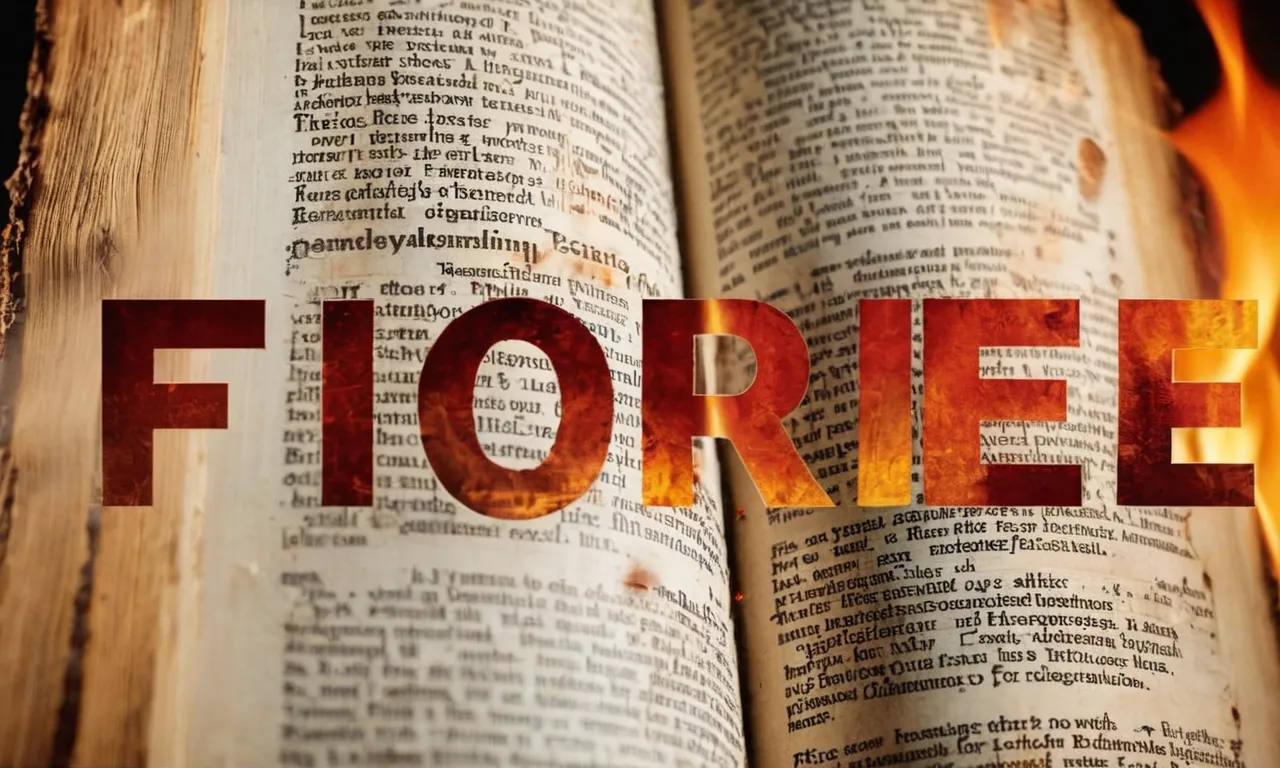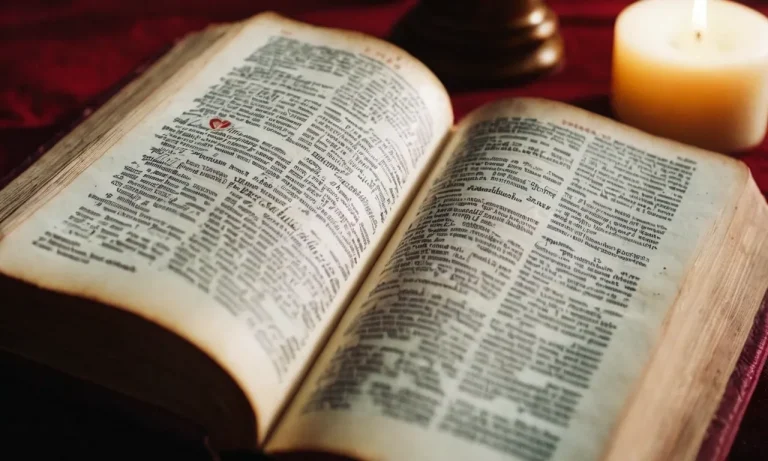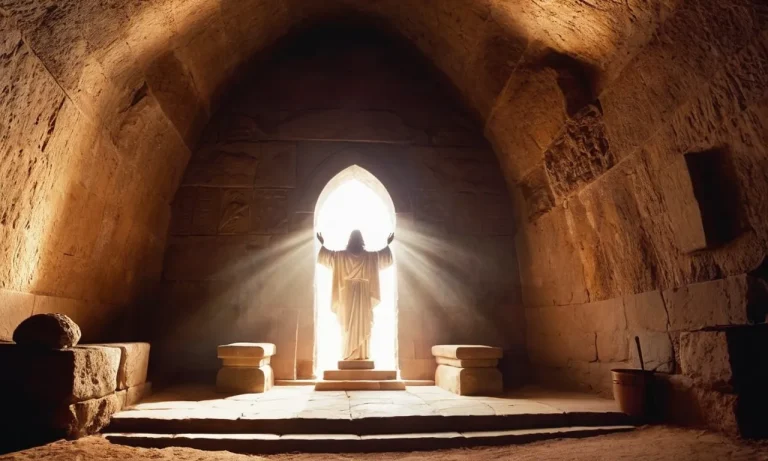How Many Times Is Fire Mentioned In The Bible?
Fire is an important symbol that appears many times throughout the Bible. From the burning bush that spoke to Moses, to the fiery furnace that Shadrach, Meshach, and Abednego emerged from unharmed, to the tongues of flame that descended on the apostles at Pentecost, fire has played a significant role in some of the Bible’s most pivotal events.
If you’re short on time, here’s a quick answer to your question: the word ‘fire’ is mentioned around 575 times in the Bible across both the Old and New Testaments.
In this comprehensive article, we will explore the many references to fire found within the pages of scripture. We will look at some of the most well-known ‘fiery’ stories of the Bible, examine how fire is used symbolically and metaphorically, and provide an approximate count for how often the word ‘fire’ appears.
Prominent ‘Fiery’ Stories of the Bible
The Burning Bush and Moses
One of the most well-known fiery stories in the Bible is when God appears to Moses in the form of a burning bush that was not consumed by the flames (Exodus 3:2). This miraculous event marks the beginning of God’s plan to free the Israelites from slavery in Egypt.
When Moses approaches the bush, God calls out to him and commissions him to lead the Israelites out of Egypt. God assures Moses that He will be with him every step of the way. This story illustrates God’s power over nature and His desire to redeem His people.
Though Moses was initially afraid, God equipped him for the task ahead through this fiery encounter.
The Fiery Furnace and Three Young Men
Another dramatic fiery story is when Shadrach, Meshach and Abednego are thrown into a blazing furnace for refusing to worship King Nebuchadnezzar’s golden idol (Daniel 3). The king furiously orders the furnace to be heated seven times hotter than usual.
Yet when the three men are thrown in, the flames do not harm them. Nebuchadnezzar is astonished to see four men walking around in the fire unharmed, with one looking like “a son of the gods.” This story displays God’s ability to protect those who remain faithful to Him even under threat of death.
He rescues the three men in a public miracle that results in Nebuchadnezzar praising the true God.
Tongues of Flame at Pentecost
At Pentecost, tongues of fire appear and rest on each of Jesus’ apostles, filling them with the Holy Spirit (Acts 2:3). Flames symbolizing God’s presence appear throughout Scripture, and here they mark a defining moment in the early church.
The disciples suddenly gain ability to speak in foreign languages and boldly preach the gospel. By day’s end, 3,000 people respond and are baptized. This fulfills Jesus’ promise to empower His followers to take the message of salvation worldwide.
The fiery tongues kick off the Spirit-led movement that continues to change hearts and lives today. God’s fiery presence initiated the church’s global reach.
Metaphorical and Symbolic Uses of Fire
God as Consuming Fire
In the Bible, God is often depicted as a consuming fire. This metaphor emphasizes God’s awesome power and his ability to destroy anything impure or unholy. Some examples include:
- Deuteronomy 4:24 says, “For the Lord your God is a consuming fire, a jealous God.” This passage warns the Israelites not to turn away from God.
- Hebrews 12:29 states, “Our God is a consuming fire.” The writer uses this image to encourage reverence for God.
- Exodus 24:17 describes God’s presence on Mount Sinai as “a consuming fire on the top of the mountain.” His fire refines and tests the people’s faith.
Fire as Purification and Cleansing
Fire is often used symbolically to represent purification, cleansing, and refinement. Several biblical passages use fire imagery in this way:
- Isaiah 1:25 says God will “smelt away your dross as with lye and remove all your alloy.” Just as metal is refined by fire, Israel will be purified from sin.
- Zechariah 13:9 describes a time when God will “refine them as one refines silver, and test them as gold is tested.” Here, fire removes impurities, leaving only pure metal.
- 1 Corinthians 3:13-15 talks about the judgment of believers’ works. Inferior works will be “burned up” by fire, a symbolic cleansing.
So fire often represents a refining process that burns away impure elements, leaving behind something cleansed and renewed. This spiritual purification by God prepares people for deeper fellowship with him.
Fire of Judgement and Wrath
The Bible frequently associates fire with God’s judgment and wrath against sin. For example:
- Deuteronomy 32:22 warns that God’s anger “will burn to the depths of Sheol.” His fiery wrath will utterly consume the disobedient.
- Psalm 97:3 says, “Fire goes before him and burns up his adversaries all around.” God will judge and destroy evildoers with blazing fire.
- 2 Thessalonians 1:7-8 describes Jesus returning “in flaming fire” to inflict vengeance on those who reject God.
So fire is a vivid symbol of the judgment coming on the wicked. But this imagery can also picture God’s disciplinary purging of sin in believers’ lives, metaphorically burning away impurities to restore holiness.
Ultimately, the fire of God’s judgment shows that evil will not go unpunished or remain undefeated.
Approximate Count of ‘Fire’ Mentions
Old Testament References
Fire is mentioned over 500 times in the Old Testament alone. It is often used literally to refer to the physical element of fire, but is also frequently used metaphorically and symbolically. Some key Old Testament passages that mention fire include:
- The burning bush from which God spoke to Moses (Exodus 3:2)
- God appearing to the Israelites as a pillar of fire (Exodus 13:21)
- God coming down on Mount Sinai in fire (Exodus 19:18)
- Elijah calling down fire from heaven (1 Kings 18:38)
- Daniel’s three friends surviving the fiery furnace (Daniel 3:26)
These examples demonstrate how fire was associated with the presence and power of God throughout the Old Testament narrative. The frequency of mentions reinforces this connection in the minds of readers.
New Testament References
Fire is also mentioned over 70 times in the New Testament. As in the Old Testament, it has both literal and metaphorical uses, including:
- John the Baptist prophesying about the coming Messiah who would baptize “with the Holy Spirit and fire” (Matthew 3:11)
- Jesus describing hell as a place of eternal fire (Mark 9:43)
- The Holy Spirit appearing as tongues of fire at Pentecost (Acts 2:3)
- Trials and suffering described metaphorically as “fiery trials” (1 Peter 4:12)
So while not as numerous as in the Old Testament, fire retains symbolic significance related to purification, the presence of God, eternal judgment, and times of testing.
Totals and Key Takeaways
Adding up approximate counts from both testaments, the word “fire” occurs over 570 times in most English Bible translations. This surprising prevalence demonstrates that fire, both literally and metaphorically, plays an enormously important role in Scripture.
Some key takeaways regarding fire in the Bible:
- Often signifies the powerful, awe-inspiring presence of God
- Associated with the Holy Spirit and concepts like purification and cleansing
- Used to represent judgment and times of difficult testing
- Remarkably pervasive imagery that would have left a deep impression on ancient listeners
So whenever you encounter fire in Scripture, consider how it may be conveying theological significance in addition to a physical reality. This can lead to some enriching insights and reflections!
Conclusion
As we have seen, fire is a recurring image used throughout scripture to convey important spiritual themes and events. By looking at some of the most significant ‘fiery’ stories of the Old and New Testaments, examining how fire metaphors teach deeper truths, and tallying up approximate counts, we gain appreciation for just how often flames flicker within the pages of the Bible.
Fire purifies, cleanses, signifies God’s presence, embodies righteous judgement and wrath against sin, and empowers his faithful servants to carry out his redeeming work in the world. When we read of fire in scripture, may we be reminded of God’s power to make all things new.








